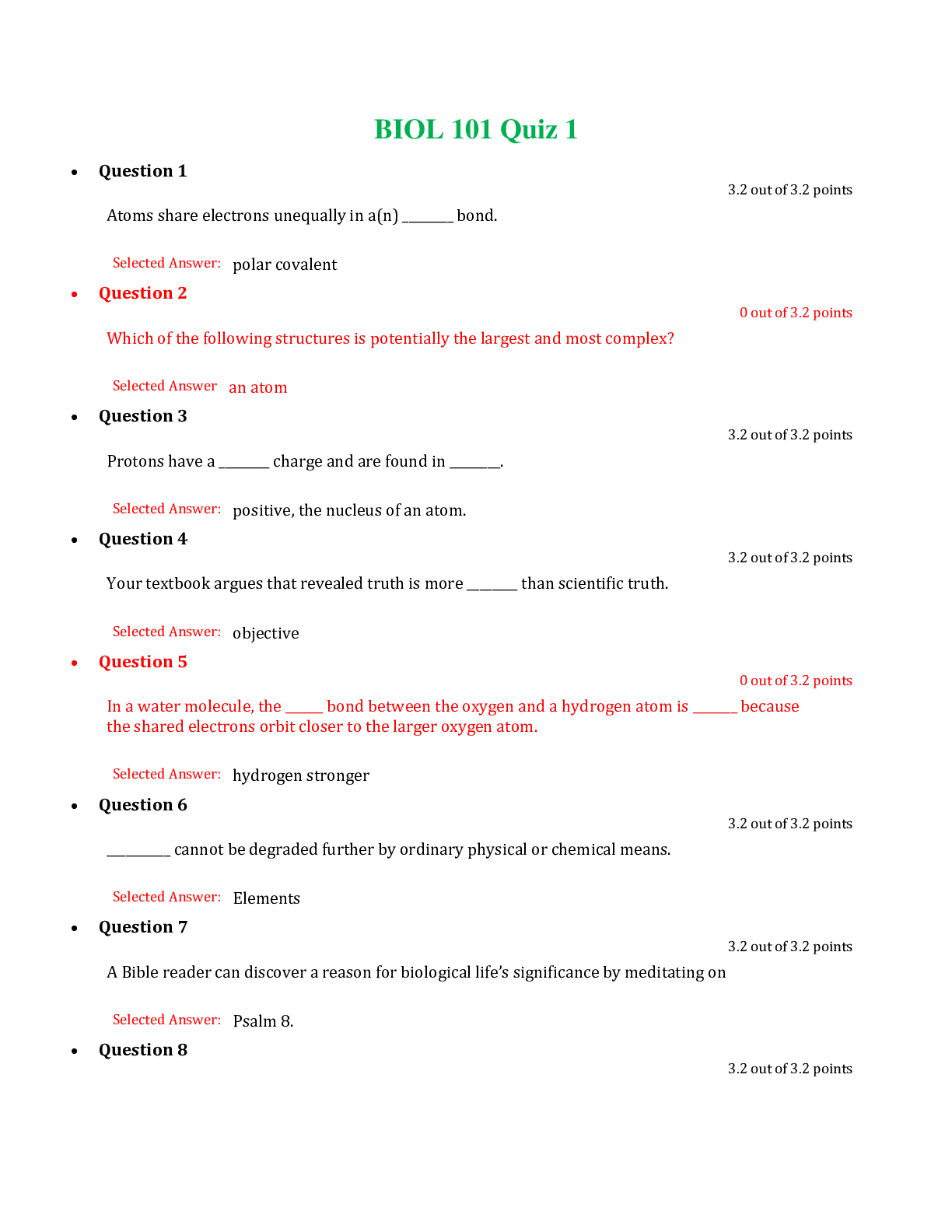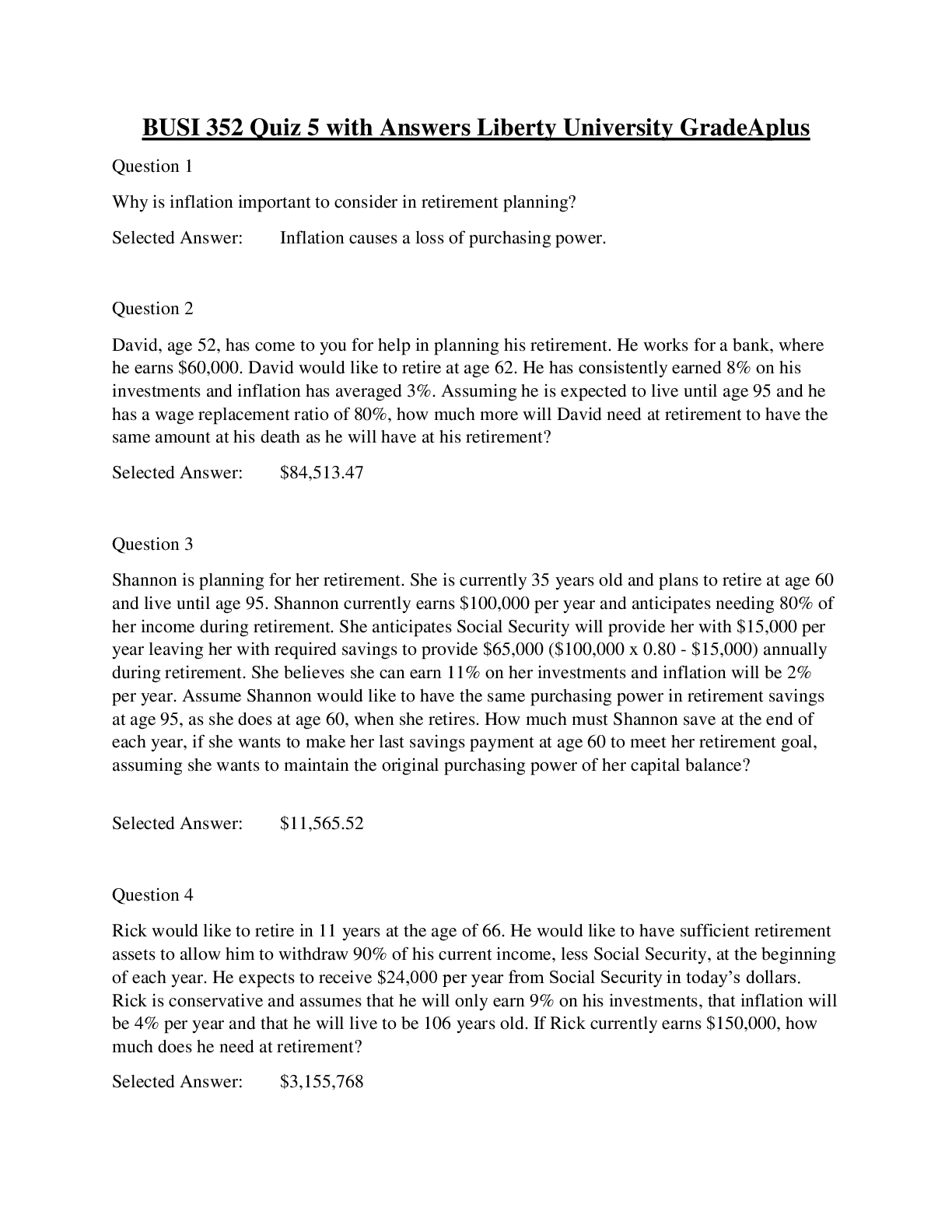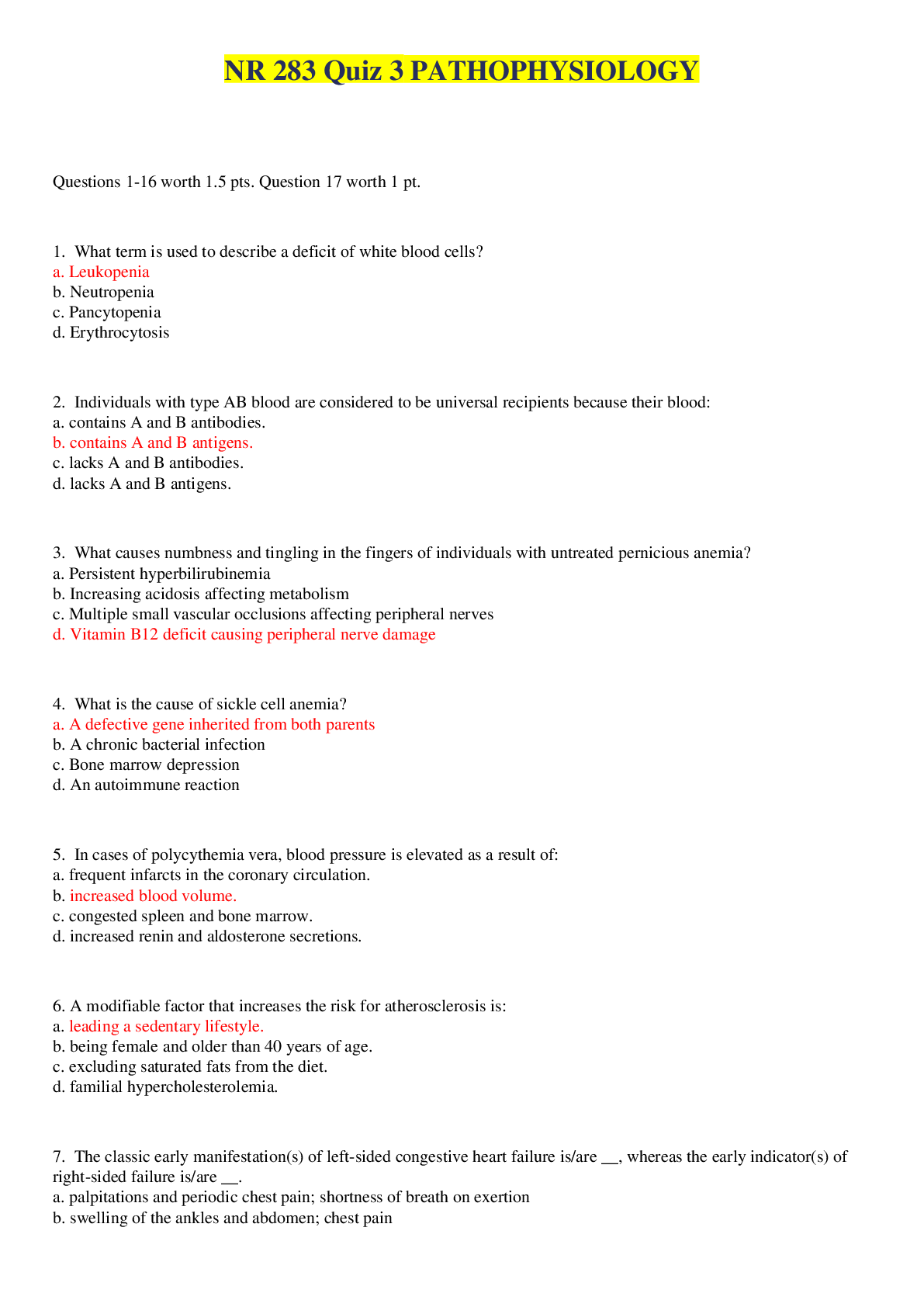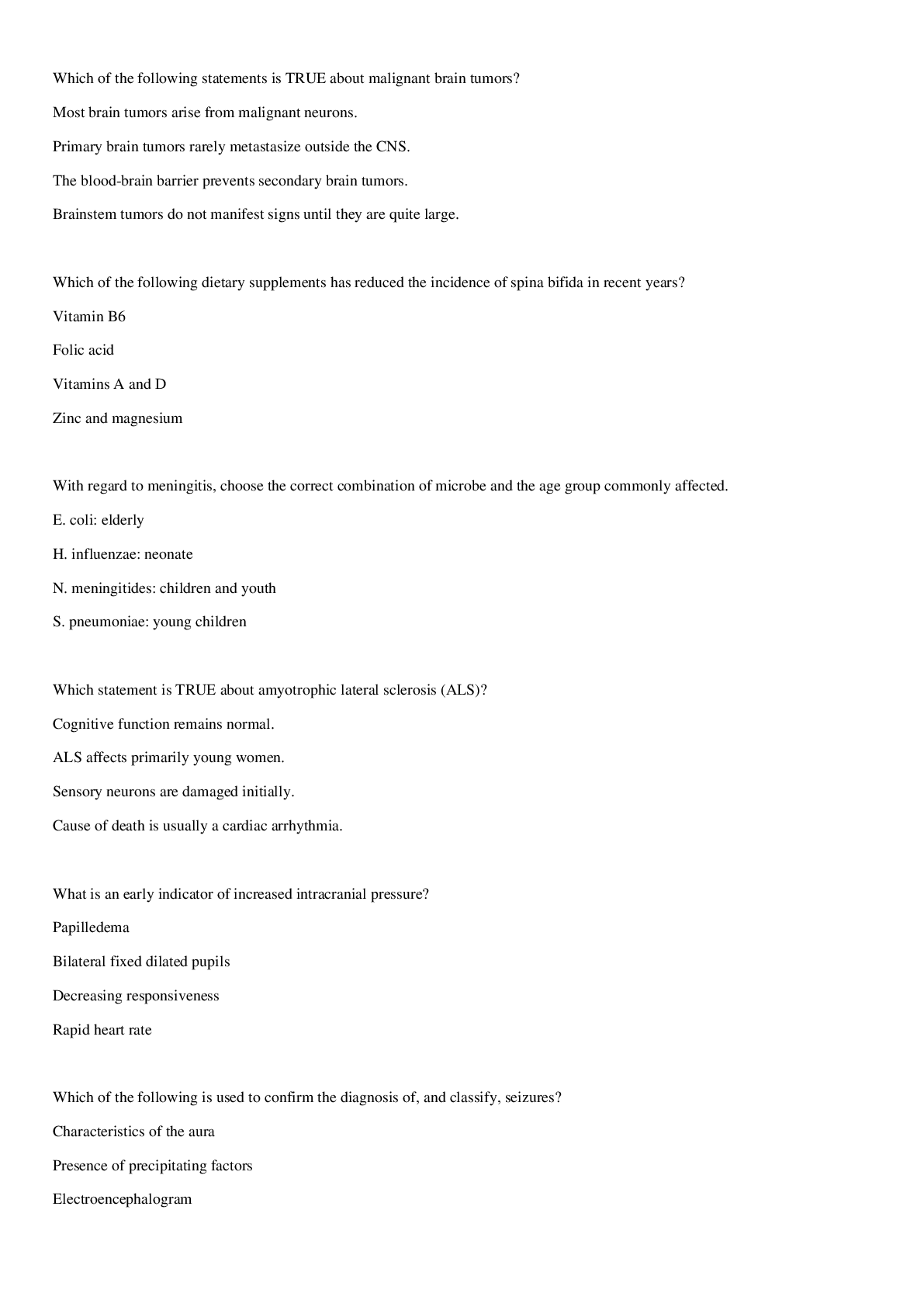*NURSING > EXAM > Chamberlain NR 283 Quiz 5/ Chamberlain NR283 Pathophysiology Quiz 5 (2019, Latest ) (Verified Answe (All)
Chamberlain NR 283 Quiz 5/ Chamberlain NR283 Pathophysiology Quiz 5 (2019, Latest ) (Verified Answers,Download to Score A)
Document Content and Description Below
NR 283 Quiz 5 1. Which of the following statements is TRUE about malignant brain tumors? a. Most brain tumors arise from malignant neurons. b. Primary brain tumors rarely metastasize outside the CN... S. c. The blood-brain barrier prevents secondary brain tumors. d. Brainstem tumors do not manifest signs until they are quite large. 1. Which of the following dietary supplements has reduced the incidence of spina bifida in recent years? a. Vitamin B6 b. Folic acid c. Vitamins A and D d. Zinc and magnesium 2. With regard to meningitis, choose the correct combination of microbe and the age group commonly affected. a. E. coli: elderly b. H. influenzae: neonate c. N. meningitides: children and youth d. S. pneumoniae: young children 3. Which statement is TRUE about amyotrophic lateral sclerosis (ALS)? a. Cognitive function remains normal. b. ALS affects primarily young women. c. Sensory neurons are damaged initially. d. Cause of death is usually a cardiac arrhythmia. 4. What is an early indicator of increased intracranial pressure? a. Papilledema b. Bilateral fixed dilated pupils c. Decreasing responsiveness d. Rapid heart rate 5. Which of the following is used to confirm the diagnosis of, and classify, seizures? a. Characteristics of the aura b. Presence of precipitating factors c. Electroencephalogram d. Changes in the characteristics of cerebrospinal fluid 6. Which of the following statements applies to a lumbar puncture? a. It is usually performed at L3-L4. b. Fluid is withdrawn from the epidural space. c. It can be used to confirm any diagnosis. d. The tissue seals up immediately after puncture. 7. What is the rationale for vomiting in a patient who has increased intracranial pressure? a. Chemoreceptors responding to changes in the blood b. Pressure extending to spinal nerves c. Pressure on the emetic center in the medulla d. Stimuli to the hypothalamic center for hunger and thirst 8. Communicating hydrocephalus causes increased intracranial pressure because of: a. atresia at the foramen magnum. b. failure of the subarachnoid to absorb CSF. c. obstruction in the lumbar area of the spinal cord. d. scar tissue from encephalitis blocking flow of CSF. 9. Creutzfeldt-Jakob disease is caused by: a. inheritance of an autosomal dominant trait. b. infection in the brain by HIV. c. an autoimmune reaction that damages nerve receptors. d. infection in the brain by a prion. 10. Which statement applies to Huntington’s disease? a. It is inherited as an autosomal recessive trait. b. It is manifested in individuals by age 20 years. c. It presents with choreiform movements in the upper body and decreased ability to concentrate. d. It causes decreased levels of all neurotransmitters in the CNS. 11. The rabies virus is usually transmitted by: a. bites from infected animals. b. respiratory droplets. c. insects such as mosquitoes. d. the fecal-oral route. 12. Which type of cerebrovascular accident (CVA) has the poorest prognosis? a. CVA caused by thrombus b. Hemorrhagic CVA c. Embolic CVA d. No difference among types 13. How is the presence of spina bifida diagnosed? a. Prenatally by ultrasound or detection of alpha-fetoprotein (AFP) in maternal blood or amniotic fluid b. Only after birth by direct observation of the sac c. After birth when the sac herniates as CSF builds up d. Only with a spinal X-ray 14. Which of the following applies to Parkinson’s disease? a. Usually develops in men and women over 60 years of age. b. There is no apparent genetic component. c. The majority of cases are predisposed by intake of antipsychotic medications. d. It rarely develops in women. 15. Which of the following is a TRUE statement about transient ischemic attacks (TIAs)? a. They usually cause necrosis and permanent brain damage. b. They may be caused by rupture of an aneurysm or a damaged artery. c. They usually indicate systemic hypertension. d. They can warn of potential cerebrovascular accidents. 16. In cases of Guillain-Barré syndrome, what does the pathophysiology include? a. Damage and loss of function in the motor neurons of the spinal cord and medulla b. Encephalopathy, with disorientation, headache, and coma c. Infection and inflammation of the motor cortex d. Inflammation and demyelination of peripheral nerves, leading to ascending paralysis 17. Which of the following classes of drugs may provide temporary improvement in cases of myasthenia gravis? a. Skeletal muscle relaxants b. Dopamine replacement drugs c. Anticholinesterase agents d. GABA replacement drugs 18. All of the following apply to tetanus infection EXCEPT: a. it is caused by an anaerobic, spore-forming bacillus. b. the exotoxin causes strong skeletal muscle spasms. c. death usually results from respiratory failure. d. signs of fever, vomiting, stiff neck, and paralysis. 19. Which of the following does NOT apply to Reye’s syndrome? a. There is no permanent damage in the body. b. It is precipitated by a combination of viral infection and administration of acetylsalicylic acid (ASA). c. Cerebral edema develops. d. Liver damage is common. 20. How does a depressed skull fracture cause brain damage? a. A bone fragment penetrates and tears brain tissue. b. A section of the skull is missing, leaving the brain unprotected. c. A section of skull bone is displaced below the level of the skull, causing pressure on the brain. d. Many fracture lines are present, causing instability. e. The contrecoup injury is the cause of brain damage. 21. The best description of a myelomeningocele is: a. asymptomatic failure of the posterior spinous processes of the vertebrae to fuse. b. herniation of the meninges through a vertebral defect. c. herniation of the meninges, CSF, and spinal cord or nerves through a vertebral defect. d. herniation of brain tissue through a defect in the cranium. 22. Which signs are indicative of post-polio syndrome? a. Progressive spastic paralysis b. Ascending flaccid paralysis c. Progressive fatigue and weakness d. Increasing numbness and paresthesias 23. What causes a herniated intervertebral disc? a. A tear in the nucleus pulposus b. A protrusion of the nucleus pulposus through the annulus fibrosis c. Displacement of the annulus fibrosis between the laminae d. Failure of the spinous processes to restrict movement of the intervertebral disc e. 24. Starting with the left atrium and ending with the pulmonary veins, list the chambers, major vessels, and valves involved in the pulmonary and systemic circulations. Left atrium_______________ [Show More]
Last updated: 2 years ago
Preview 1 out of 5 pages

Buy this document to get the full access instantly
Instant Download Access after purchase
Buy NowInstant download
We Accept:

Reviews( 0 )
$19.00
Can't find what you want? Try our AI powered Search
Document information
Connected school, study & course
About the document
Uploaded On
May 12, 2020
Number of pages
5
Written in
Additional information
This document has been written for:
Uploaded
May 12, 2020
Downloads
0
Views
77

























